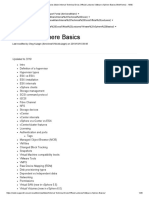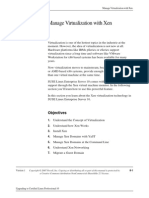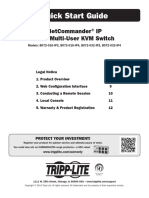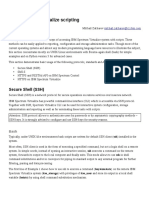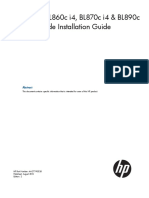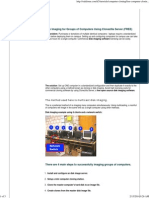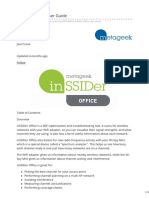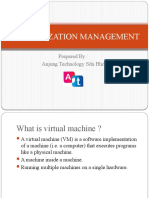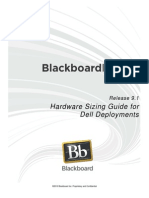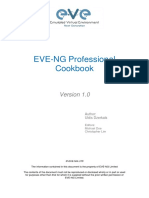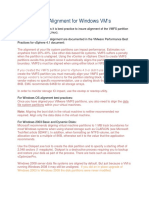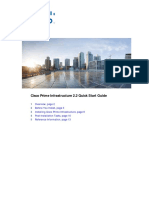VMware10 0 1-1379776
VMware10 0 1-1379776
Uploaded by
Niklas Tokbollen RiddarloCopyright:
Available Formats
VMware10 0 1-1379776
VMware10 0 1-1379776
Uploaded by
Niklas Tokbollen RiddarloOriginal Title
Copyright
Available Formats
Share this document
Did you find this document useful?
Is this content inappropriate?
Copyright:
Available Formats
VMware10 0 1-1379776
VMware10 0 1-1379776
Uploaded by
Niklas Tokbollen RiddarloCopyright:
Available Formats
VMware Workstation 10 delivers best-in-class Windows 8 support, and innovative new features that transform the way technical
professionals work with virtual machines, whether they reside on their PCs or on private enterprise clouds. *New Operating System Support Support has been added for: -Windows 8.1 -Windows 8.1 Enterprise -Windows Server 2012 R2 -Ubuntu 13.10 As well as for the latest Fedora, CentOS, Red Hat and OpenSUSE releases. *VMware Hardware Version 10 This version of VMware Workstation includes VMware hardware Version 10 and is compatible with vSphere 5.5. Hardware versions introduce new virtual hardware functionality and new features while enabling VMware to run legacy operating systems in our virtual machines. New features included in this hardware version: *16 vCPUs Virtual machines can now run with up to 16 virtual CPUs. This enables very processor intensive applications to be run in a virtual machine. Note: Running virtual machines with 16 vCPUs requires that both your host and guest operating system support 16 logical processors. Your physical machine must have at least 8 cores with hyper-threading enabled to power on a virtual machine with this configuration. *8 Terabyte Disks Virtual machines can now include virtual disks greater than 2 Terabytes. Given the limitations of most operating systems to boot from disks greater than 2 Terabytes, These large disks are most useful as secondary drives for file storage. Note: To use a disk greater than 2TB for a boot disk, your guest operating system would need to boot using EFI in order to read a GPT formatted disk which is required to access all of the sectors on a disk of this size. Additionally, the Buslogic controller is not capable of supporting a disk greater than 2TB. Extra murphy78 note: To enable EFI boot mode, edit the .VMX file and add: firmware = "efi" Alternatively, to set it back to bios (legacy) boot, change to: firmware = "bios" *Virtual SATA Disk Controller A SATA I/O controller can now be selected during the creation of a custom virtual machine in addition to an IDE and SCSI controller. This enables use of in-box SATA drivers that are shipped with operation systems. *USB Improvements USB 3 Streams have been implemented to enable high speed transfer of files from USB 3 external storage devices that support this technology. For customers running Workstation 10 on laptops with small hard disks, large data files, video files etc., can be stored on an external USB 3 storage device and accessed quickly from within the virtual machine. VMware has also addressed issues Intel, NEC, AMD, TI and Linux Kernel host xHCI drivers to improve overall USB 3 compatibility and performance.
*More VMnets Due to demand, VMware has doubled the number of VMnets in Workstation 10 to twenty! This provides you with more virtual networks to dedicate to specific uses, and it enables more complex networked virtual environments to be built. *SSD Pass-through Windows 8 is capable of detecting when it is being run from a solid state drive (SSD) and optimizes itself for this hardware. In Workstation 10, the guest operating system will be able to detect when the virtual machine Disk file is being stored on an SSD drive and the operating system can make the same optimizations when it is running in a virtual machine. Many additional changes have been made to this Hardware Version including some performance improvements, power savings, and compatibility with new processors. We have also made significant improvements in the startup time of VMware Workstation and in Windows boot time when running Windows virtual machines. *Expiring Virtual Machines VMware has enhanced the capabilities of Restricted Virtual Machines to include the ability to expire a virtual machine on a specified date and time. This feature enables our customers to create virtual machines to be shared with employees, students, customers, contractors, etc. The restricted virtual machine will run until their contract terminates, demo runs out, or course ends. The expiring capability establishes a secure connection to a web server to validate the current date and time and prevent users from rolling back their system clock to circumvent the logic. The ability to set the synchronization frequency has been added to allow customers to balance the need for timely expiration and the load on their network. Expiring virtual machines also include the ability to display a custom message for virtual machines about to expire and after a virtual machine has expired. Finally, a lease period can be defined to allow users to run offline for plane trips and remote work. *Virtual Tablet Sensors Workstation runs very well on the new tablet and convertible PCs. Last year VMware enabled touch screen input to be passed through to the virtual machine. Workstation 10 introduces a virtual Accelerometer, Gyroscope, Compass and Ambient Light sensor. Customers who run Workstation 10 on a Windows 8 tablet and install Windows 8 in a VM, will be able to shake, twirl, tilt, and spin their tablet and sensor aware applications running in a virtual machine will respond accordingly. *User Interface Enhancements There are many user interface improvements that we have included in the Workstation 10 release. The highlights include: *Windows 8 Unity Mode Support We are continuing to improve how the Workstation Unity user-interface works with Microsoft's "Modern UI" or the "Microsoft Design Language" (The new tile interface in Windows 8 formerly known as Metro). Microsoft Store applications are now available in the Unity menu and can be launched directly from it.
*Multiple Monitor Navigation When running with 2, 3, 4 or more monitors it has been frustrating to use the full screen mode in Workstation and toggle through each combination of monitors to get to the one you want. The full screen toolbar now has an option to choose your configuration from a menu and jump to it immediately. *Power Off Suspended Virtual Machines Workstation 10 lets you simply power off a suspended Virtual Machine in order to make changes to the configuration without powering it on and then off first. Powering off a suspended virtual machine will lose any information stored in memory, but will not lose anything saved to the virtual disk. *Remote Hardware Upgrade When working with virtual machines running remotely on vSphere or on another instance of Workstation, you can now remotely upgrade the virtual hardware version. *Localized into Simplified Chinese The Workstation user interface and online help has been translated into Simplified Chinese. *New Converter This release includes the latest version of the VMware Standalone Converter. The Converter enables users to turn a physical machine into a virtual machine. This version of the Converter includes the ability to convert machines running Windows 8, Windows Server 2012, and RHEL 6 operating systems. It supports virtual and physical machines with Unified Extensible Firmware Interfaces (UEFI) and EXT4 file systems as well as GUID Partition Table (GPT) disks. *OVFTool The Open Virtual Machine Format (OVF) is a virtual machine distribution format that supports sharing virtual machines between products and organizations. The VMware OVF Tool is a command-line utility that enables a user to import and export OVF packages to and from a wide variety of VMware products. The latest release of the OVFTool is included with VMware Workstation 10 and is used to upload and download virtual machines to and from vSphere. The OVFTool is also used to import an .OVF file which may come in handy when importing virtual machines created using desktop virtualization software developed by Oracle. *VMRun Enhancements The VMRun command line utility has been enhanced with two new options getGuestIPAddress and checkToolsState to retrieve the IP address of the guest operating system and determine the state of VMware Tools in a guest. *Cloud Management Tools The VMware Workstation team has been making enhancements and working with partners to enable cloud management tools to be used with virtual machines running in VMware Workstation 10. *We would like to thank Mitchell Hashimoto at Vagrant for his development of the Vagrant VMware Provider. See http://www.vagrantup.com/vmware for more information. *VMware would also like to thank Christian Hammond for the development of a Chef knife plug-in for VMware Workstation. See https://github.com/chipx86/knife-wsfusion for more information. *Embedded 30-day Trial Workstation 10 can now be evaluated for 30-days by simply entering your
email address the first time you run the application. This change is intended to make it much easier for our customers to learn about the latest release of VMware Workstation without their license keys being trapped by spam filters. *VMware KVM Many of our customers have asked for a way to run a virtual machine so that their users do not realize they are running in a virtual machine. VMware Workstation 10 includes a new executable (on Windows only for now) called VMware KVM. Run vmware-kvm.exe vmx-file.vmx from the command line and your virtual machine will launch in full screen with no toolbar or any other indicator that you are running a VM. You can use Ctrl-Alt to ungrab from the virtual machine and the Pause/Break key to toggle between multiple virtual machines running under VMware KVM, or between a virtual machine and the host system. The user experience should be just like that of using a KVM switch hence the name. If you simply type vmware-kvm.exe from the command line you will get some options that can be used in this format: vmware-kvm.exe [OPTIONS] vmx-file.vmx If you run vmware-kvm.exe --preferences you will presented with an interface that allows you to configure certain behaviors such as the key used to cycle between virtual machines. This is the latest generation of an executable previously called VMware-fullscreen.exe that previously shipped with Workstation 8 with a major upgrade in display handling. *WSX 1.1 Try out the latest version of WSX which can be found on the VMware Communities page at: https://communities.vmware.com/community/vmtn/wsx. Resolved Issues The following issues are resolved in this release of VMware Workstation. *Easy Install supports RTM versions of Windows 8.1 and Windows Server 2012 R2 Easy Install now supports RTM versions of Windows 8.1 and Windows Server 2012 R2. *Workstation or Player on Windows freezes if another application is frozen. Other stuck Windows applications could cause Workstation or Player to freeze while waiting for the application to respond. *Virtual machine hangs when powering off Rarely, virtual machines will cease functioning (hang) while powering off, particularly if the guest OS was in the middle of a BSOD or kernel panic. *Improved compatibility with some AMD CPUs Updated masking to match capabilities of certain AMD PileDriver CPUs. *Virtual machines displayed incorrectly on a multi-monitor Windows host when the displays have differing pixel density (DPI.) *Boot from CD/DVD when Legacy Floppy is disabled Known Issues Known issues from prior releases of VMware Workstation 10 also might apply to VMware Workstation 10.0.1.
*Workstation UI may crash when creating full clones of very large virtual machines Workstation for Windows may run out of memory creating a full clone of a virtual machine with virtual disks many terabytes in size. Workaround: Copy the virtual machine outside VMware Workstation or use VMware Workstation for Linux. *Cannot launch Workstation in Red Hat Enterprise Linux 6.4 If you cannot launch Workstation on a Red Hat Enterprise Linux 6.4 host, you may not have sudo access in gksu. Workaround: Change your gksu settings in /etc/vmware/config, using gksu.rootMethod. Set gksu.rootMethod to sudo or su. *Hot-plug operations involving SATA virtual disks do not work VMware Workstation allows you to add virtual disks connected to the SATA adapter while the virtual machine is powered on. When you do this, Workstation shows the operation was successfully completed, but disks are not visible to the operating system installed in the virtual machine. Workaround: Power off the virtual machine, connect the disk, then power the virtual machine back on. *ODBC driver creation shuts down when shared folders are enabled on a Windows 2008 guest When creating an ODBC driver for use in mapping a drive, the ODBC dialog disappears during the step when you select a Workbook and choose a folder and Workstation crashes. Workaround: Do not map any VMware shared folders as drive letters. Use the Universal Naming Convention (UNC) paths instead, for example: \\vmware-host\Shared Folders\ *VMware Tools changes cause black screen in virtual machine After VMware Tools are uninstalled or automatically upgraded for a Windows 8.0 virtual machine, the virtual machine may display as a black screen for two minutes. Workaround: Install Windows 8.0 update KB2836988 or upgrade to Windows 8.1. Do not shut down the virtual machine when it is in black screen.
You might also like
- VMware Horizon 8 Cheat Sheet ENDocument6 pagesVMware Horizon 8 Cheat Sheet ENPeter BendanaNo ratings yet
- Information Technology Useful Links in Web - V1Document67 pagesInformation Technology Useful Links in Web - V1srinivas100% (1)
- Replacing A Fabric InterconnectDocument14 pagesReplacing A Fabric Interconnect陳俊平No ratings yet
- Iomega-Root Access Enabling (Home Media CE)Document6 pagesIomega-Root Access Enabling (Home Media CE)ssacs0% (2)
- RH8100 V3 Server V100R003 User Guide 29 PDFDocument378 pagesRH8100 V3 Server V100R003 User Guide 29 PDFLeonardo ArnoldNo ratings yet
- VMware Vsphere BasicsDocument28 pagesVMware Vsphere BasicsBellcini PrintNo ratings yet
- ChronoSync 4.5 ManualDocument37 pagesChronoSync 4.5 Manualalmendro22No ratings yet
- Nikon D90 12Document3 pagesNikon D90 12Hoang DHNo ratings yet
- Nikon D90Document1 pageNikon D90ggubi61No ratings yet
- Manual para La Gestión de Software - Fedora16Document187 pagesManual para La Gestión de Software - Fedora16Cristian ClebiroNo ratings yet
- © SANS Institute 2002, Author Retains Full Rights.: Macintosh Forensic Analysis Using Os XDocument13 pages© SANS Institute 2002, Author Retains Full Rights.: Macintosh Forensic Analysis Using Os XBob BobNo ratings yet
- Fedora ServerDocument38 pagesFedora ServerTestoje TestovićNo ratings yet
- Creating and Configuring FTP Sites in Windows Server 2003Document18 pagesCreating and Configuring FTP Sites in Windows Server 2003rkballaniNo ratings yet
- Install OMV On Iomega HMNHD Cloud Edition With Disk Image - v05Document4 pagesInstall OMV On Iomega HMNHD Cloud Edition With Disk Image - v05KApps KAppsNo ratings yet
- Windows ServerDocument4 pagesWindows ServerbatmansniperNo ratings yet
- CameraDocument4 pagesCameraawais_sohail89No ratings yet
- Installation Kali Linux 2023Document2 pagesInstallation Kali Linux 2023venkatesh.ecapsNo ratings yet
- Lab1 Lab2Document17 pagesLab1 Lab2chente_misfitNo ratings yet
- Learn To Set Up and Use PowerShell SSH RemotingDocument11 pagesLearn To Set Up and Use PowerShell SSH Remotingyopitufo1956No ratings yet
- Lab 1: Installing The Fedora OS On A Virtual Machine: Learning OutcomeDocument40 pagesLab 1: Installing The Fedora OS On A Virtual Machine: Learning OutcomeHoàng VõNo ratings yet
- How To Back Up and Restore VMware ESXi Host ConfigurationDocument25 pagesHow To Back Up and Restore VMware ESXi Host ConfigurationHenry SalonicaNo ratings yet
- Installing PowerShell On macOSDocument6 pagesInstalling PowerShell On macOSAnonymous enr3NGjNo ratings yet
- 2921Document8 pages2921iwanNo ratings yet
- Fusion 13 For Apple Silicon Companion v19Document75 pagesFusion 13 For Apple Silicon Companion v19Elan QisthiNo ratings yet
- How To Set Up FTP Server For Ifs Document ManagementDocument4 pagesHow To Set Up FTP Server For Ifs Document ManagementIndika Ranasinghe0% (1)
- Fusion InstallationDocument11 pagesFusion Installationpurcina123No ratings yet
- Installation and Usage Guide of The New Generic USB DAC Driver For FiiO PlayersDocument16 pagesInstallation and Usage Guide of The New Generic USB DAC Driver For FiiO PlayersArmando SgabeiNo ratings yet
- Catalogs (4+1)Document68 pagesCatalogs (4+1)Danijel DanicicNo ratings yet
- PHPDocDocument8 pagesPHPDocscribdsoundNo ratings yet
- How To Install A Custom Rom On A Cube Talk 9X U65GTDocument5 pagesHow To Install A Custom Rom On A Cube Talk 9X U65GTAnonymous Dq4Srv0% (1)
- XENDocument44 pagesXENMelchior260No ratings yet
- Extron MVX 1616 PDFDocument1 pageExtron MVX 1616 PDFBrianNo ratings yet
- How Do I Manually Boot HP-UX On Integrity (Itanium) Based SystemsDocument6 pagesHow Do I Manually Boot HP-UX On Integrity (Itanium) Based Systemsnilu772008No ratings yet
- Powerha Systemmirror For Aix V7.1 Two-Node Quick Configuration GuideDocument34 pagesPowerha Systemmirror For Aix V7.1 Two-Node Quick Configuration Guideassane baNo ratings yet
- How To Edit Video in After EffectsDocument13 pagesHow To Edit Video in After EffectsBonggo PramonoNo ratings yet
- HowtoDocument2 pagesHowtoFernandoQuintoCordobaNo ratings yet
- Monitoring VMware With Nagios XIDocument3 pagesMonitoring VMware With Nagios XIeliadibNo ratings yet
- Quick Start Guide: Netcommander Ip Cat5 Multi-User KVM SwitchDocument12 pagesQuick Start Guide: Netcommander Ip Cat5 Multi-User KVM SwitchJesus ChavezNo ratings yet
- Remote-Support DS8000 v1.7Document14 pagesRemote-Support DS8000 v1.7ivancristiNo ratings yet
- Ibm SVC Storwize ScriptingDocument14 pagesIbm SVC Storwize ScriptingAakashNo ratings yet
- Network Camera User GuideDocument22 pagesNetwork Camera User Guideregizal100% (1)
- Huawei FusionServer IBMC Software White PaperDocument57 pagesHuawei FusionServer IBMC Software White PaperАндрей ИвановNo ratings yet
- GEI-100189A System Database (SDB) Windows - Based ClientServer PDFDocument22 pagesGEI-100189A System Database (SDB) Windows - Based ClientServer PDFmeirangongNo ratings yet
- HP Integrity BL860c I4, BL870c I4 & BL890c I4 Server Blade Installation GuideDocument28 pagesHP Integrity BL860c I4, BL870c I4 & BL890c I4 Server Blade Installation GuideSladur BgNo ratings yet
- HP UX All Commands.Document590 pagesHP UX All Commands.Bahaa MurNo ratings yet
- Intro To Prometheus Workshop - GrafanaDocument67 pagesIntro To Prometheus Workshop - GrafanaandreiionitaNo ratings yet
- Windows Shell - WikipediaDocument7 pagesWindows Shell - WikipediamjdiaznoveloNo ratings yet
- Disk Imaging For Groups of Computers Using Clonezilla Server (FREE)Document17 pagesDisk Imaging For Groups of Computers Using Clonezilla Server (FREE)S MoorthyNo ratings yet
- IBM DS8880 Product GuideDocument36 pagesIBM DS8880 Product Guidedileep7No ratings yet
- Vtiger CRM 520 Asterisk Integration Inbound Calls Pop Ups ProblemDocument13 pagesVtiger CRM 520 Asterisk Integration Inbound Calls Pop Ups ProblemJosseUrbinaNo ratings yet
- Basic Linux Commands ESXIDocument7 pagesBasic Linux Commands ESXIRoshan RaviNo ratings yet
- 02 BVMS VERSION 5 5 ReleaseNotes v3 PDFDocument38 pages02 BVMS VERSION 5 5 ReleaseNotes v3 PDFLucianaNo ratings yet
- FreePBX and Raspberry PiDocument6 pagesFreePBX and Raspberry PiDewiNo ratings yet
- Tecnomatix 9.1.2 InstallationDocument81 pagesTecnomatix 9.1.2 InstallationDomingo GarcíaNo ratings yet
- HP Superdome 2 Partitioning Administrator Guide (5900-2540, December 2012) PDFDocument126 pagesHP Superdome 2 Partitioning Administrator Guide (5900-2540, December 2012) PDFSladur BgNo ratings yet
- FTP Server in Windows 2012Document4 pagesFTP Server in Windows 2012aami6No ratings yet
- Dell Unity - Software Upgrade Procedures-Performing Software UpgradesDocument28 pagesDell Unity - Software Upgrade Procedures-Performing Software UpgradesRa YuthNo ratings yet
- InSSIDer Office User GuideDocument13 pagesInSSIDer Office User GuidevilaounipNo ratings yet
- Install Vmware Player 6.0.0 On Ubuntu 13.04: General Email This PostDocument5 pagesInstall Vmware Player 6.0.0 On Ubuntu 13.04: General Email This PostsuntheirNo ratings yet
- What's New in Vsphere 5Document3 pagesWhat's New in Vsphere 5Rocco DraganiNo ratings yet
- Fortinac Vmware Install 85Document30 pagesFortinac Vmware Install 85Giorgio StefaniNo ratings yet
- Virtualization Management: Prepared By: Anjung Technology SDN BHDDocument17 pagesVirtualization Management: Prepared By: Anjung Technology SDN BHDrush_aztechNo ratings yet
- NetBackup 7.6 Cheat SheetDocument4 pagesNetBackup 7.6 Cheat SheetMatthew GoffNo ratings yet
- Cost and Performance Comparison For OpenStack Compute and Storage InfrastructureDocument19 pagesCost and Performance Comparison For OpenStack Compute and Storage InfrastructurePrincipled TechnologiesNo ratings yet
- VMware Hands-On Lab Experiments - NHOP02Document6 pagesVMware Hands-On Lab Experiments - NHOP02vfxNo ratings yet
- How To Install Vmware Workstation 12 Pro?Document6 pagesHow To Install Vmware Workstation 12 Pro?ONHS J MejiaNo ratings yet
- Blackboard Learn 9.1 Hardware Sizing Guide For Dell DeploymentsDocument16 pagesBlackboard Learn 9.1 Hardware Sizing Guide For Dell DeploymentsKingboy MokNo ratings yet
- Mastering VMware Vsphere Storage - Sample ChapterDocument28 pagesMastering VMware Vsphere Storage - Sample ChapterPackt PublishingNo ratings yet
- Sean Dickerson ResumeDocument3 pagesSean Dickerson ResumeSeanNo ratings yet
- Dell Emc Powerstore: Vmware Vsphere Best PracticesDocument25 pagesDell Emc Powerstore: Vmware Vsphere Best PracticesBalasubramanian ReguramanNo ratings yet
- VMware ESXDocument133 pagesVMware ESXneohm24No ratings yet
- Rp4vms Installation Deployment Guide 5 3 3 3 en UsDocument67 pagesRp4vms Installation Deployment Guide 5 3 3 3 en Usakhtar.011064No ratings yet
- Dell Openmanage Enterprise v32 - White Papers2 - en UsDocument24 pagesDell Openmanage Enterprise v32 - White Papers2 - en UsTechnicianccnaNo ratings yet
- Understanding and Troubleshooting UCS LicensingDocument13 pagesUnderstanding and Troubleshooting UCS LicensingNguyen Ngoc DuyNo ratings yet
- VMware Vsphere 5Document3 pagesVMware Vsphere 5Kiran DevadasNo ratings yet
- 3PAR Remote Copy With VMware Site Recovery ManagerDocument15 pages3PAR Remote Copy With VMware Site Recovery ManagerYordanka Atanasova StoyanovaNo ratings yet
- Eve Cook Book 1.0Document197 pagesEve Cook Book 1.0msamuelfNo ratings yet
- Operating System Structures: Bilkent University Department of Computer Engineering CS342 Operating SystemsDocument58 pagesOperating System Structures: Bilkent University Department of Computer Engineering CS342 Operating SystemsMuhammed NaciNo ratings yet
- VMware AlignmentDocument2 pagesVMware Alignmentkuldeep_singh_144No ratings yet
- Cisco Prime 2.2 GuideDocument16 pagesCisco Prime 2.2 Guidemaverick2689No ratings yet
- Disaster Recovery Virtualization Protecting Production Systems Using VMware Virtual Infrastructure and DoubleTakeDocument17 pagesDisaster Recovery Virtualization Protecting Production Systems Using VMware Virtual Infrastructure and DoubleTakeAnton AnNo ratings yet
- RecoverPoint - Change RPA Installation Parameters-5.3 SP3Document55 pagesRecoverPoint - Change RPA Installation Parameters-5.3 SP3hieuptNo ratings yet
- Virtualization Power Point PresentationDocument376 pagesVirtualization Power Point PresentationHEMANTH100% (1)
- Vmware All Product OveriewDocument74 pagesVmware All Product OveriewSunil GentyalaNo ratings yet
- Tech Preview Tips and Techniques V5Document28 pagesTech Preview Tips and Techniques V5Anonymous e0IBDMNo ratings yet
- EMC Atmos Demo Ver Install GuideDocument12 pagesEMC Atmos Demo Ver Install GuideshihabudinaNo ratings yet
- SRM Admin 6 0Document166 pagesSRM Admin 6 0gopikiran6No ratings yet
- VMC Aws OperationsDocument136 pagesVMC Aws OperationsCristian GeorgiuNo ratings yet
- FC Admin Guide 0Document35 pagesFC Admin Guide 0Arghya ChatterjeeNo ratings yet





